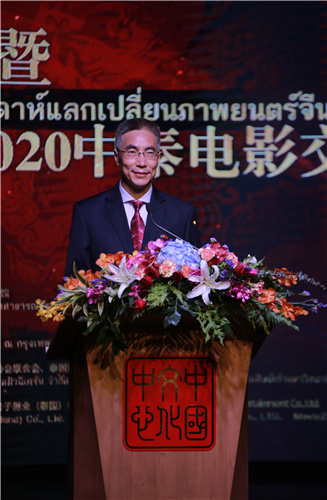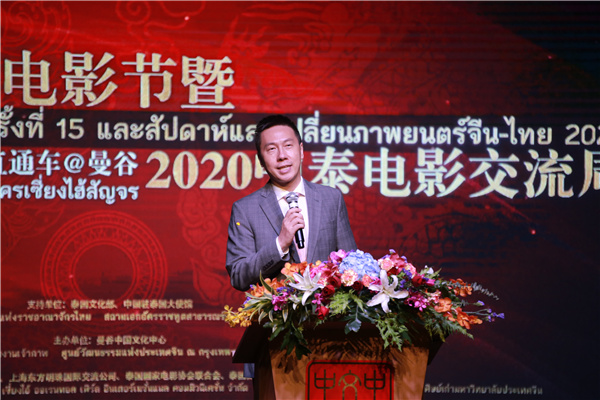 |
An exhibition in Shanghai displays a new collection featuring Tibetan elements and handicrafts related to Tibetan embroidery. [PHOTO BY HE QI/CHINA DAILY] |
Tibetan embroidery from Guinan county in Qinghai province's Hainan Tibet autonomous prefecture, traditional hair-braid decorations and other ethnic elements featured in a recent show at Shanghai Fashion Week.
Launched in 2014, the brand MUKZIN insisted on stylishly displaying traditional Chinese culture.
The spring/summer 2021 collection focuses on Guinan county and uses fashion to deduce the theme of how the traditional becomes the contemporary.
The new collection is inspired by jialong-traditional hair-braid decorations worn by ethnic Tibetan women-and combined with the officially listed Qinghai's provincial-level intangible cultural heritage of Tibetan embroidery. This is presented in such details and totems as flowers and fruits with blessings written in Tibetan.
"This is the second time that we've chosen intangible cultural heritage as a theme for a collection since the autumn/winter 2018 collection featured embroidery from the Xinjiang Uygur autonomous region," MUKZIN designer Han Wen says.
"This time, we hope to give Tibetan embroidery a more modern expression so it can be better integrated into contemporary clothing."
MUKIZIN CEO Feng Guang says the collection also uses some elements from Chinese comics.
"We know that Europe and the United States have characters like Superman, and Japan also has its style of comic-book characters. In fact, China also has many local characters," Feng says.
"So, we combine them and graffiti patterns with advanced fashion."
But it's still not easy to integrate a brand with traditional culture.
"I think the difficulty lies in the fact that we don't have much to learn from because we've always been an explorer in combining national culture, including Chinese handicrafts, with fashion," Feng says.
"As an explorer, we still need to spend a lot of time and energy to do original designs. And we find that it's very difficult to collect comprehensive intangible cultural-heritage data because it's not systematic. So, we have to methodically sort traditional culture before outputting the concept that we want to combine with the current design.
"Moreover, there's a conflict between current fashion sense and traditional elements. We've been seeking to balance this."
Apart from the fashion show, MUKIZIN co-hosted a weeklong exhibition with LIHESpace from Oct 11 to 16. It not only displayed the collection but also handicrafts and techniques related to Tibetan embroidery to use contemporary language to communicate and interact across traditional culture and modern audiences.
"We felt the fashion show wasn't enough to comprehensively convey Tibetan embroidery culture," Feng says.
"The exhibition can express the aesthetic in different ways. We hope it can help audiences think and understand more deeply."
 |
The 15th Chinese Film Festival in Bangkok and the 2020 China-Thailand Film Exchange Week opens at the China Cultural Center in Bangkok on Oct 25, 2020. [Photo provided to Chinaculture.org] |
On Oct 25, the opening ceremony of the 15th Chinese Film Festival in Bangkok and the 2020 China-Thailand Film Exchange Week was held at the China Cultural Center in Bangkok. The event was hosted by the China Cultural Center in Bangkok and received strong support from the Chinese Embassy in Thailand and the Thai Ministry of Culture.
The COVID-19 pandemic doesn't impede the enthusiasm for cultural exchange between China and Thailand. This film festival uses live broadcast to present the opening ceremony and host the "China-Thailand Film Exchange and Cooperation Online Seminar". During the film festival, audiences can use the online platform of the China Cultural Center in Bangkok to watch films online, which greatly increases the global reach of the festival.
 |
Gu Hongxing, director of the China Cultural Center in Bangkok and China Tourism Office in Bangkok, speaks at the opening ceremony. [Photo provided to Chinaculture.org] |
Gu Hongxing, director of Bangkok's China Cultural Center and China Tourism Office, said film can not only introduce one's national culture, but also reflect unique social landscapes. Film has become an important part of cultural exchange between countries and enhance mutual understanding among people around the world.
 |
Yang Xin, Chargé d'affaires of the Chinese Embassy in Thailand, speaks at the opening ceremony. [Photo provided to Chinaculture.org] |
Yang Xin, Chargé d'affaires of the Chinese Embassy in Thailand, said since the establishment of diplomatic relations between China and Thailand 45 years ago, the mutual trust between the two countries has continued to deepen, economic and trade cooperation has expanded, cultural exchanges have become closer, and all-around cooperation has achieved fruitful results. Both China and Thailand have a vast film market. As a traditional project of cultural exchanges between China and Thailand, the Bangkok Chinese Film Festival has laid a solid foundation for film cooperation between the two countries for 15 years and will add new drive to the promotion of cultural exchanges and cooperation between China and Thailand.
 |
Itthiphol Kunplome, Thailand's minister of culture, speaks at the opening ceremony. [Photo provided to Chinaculture.org] |
Thailand's Minister of Culture Itthiphol Kunplome said in his speech the governments and people of Thailand and China have been in constant exchange. Cooperation in various fields has developed steadily, and the film festival is another important event to further promote cultural exchanges between the two countries. The people of the two countries can promote their understanding of the cultures of both sides through films, and promote friendly relations and cooperation in other perspectives.